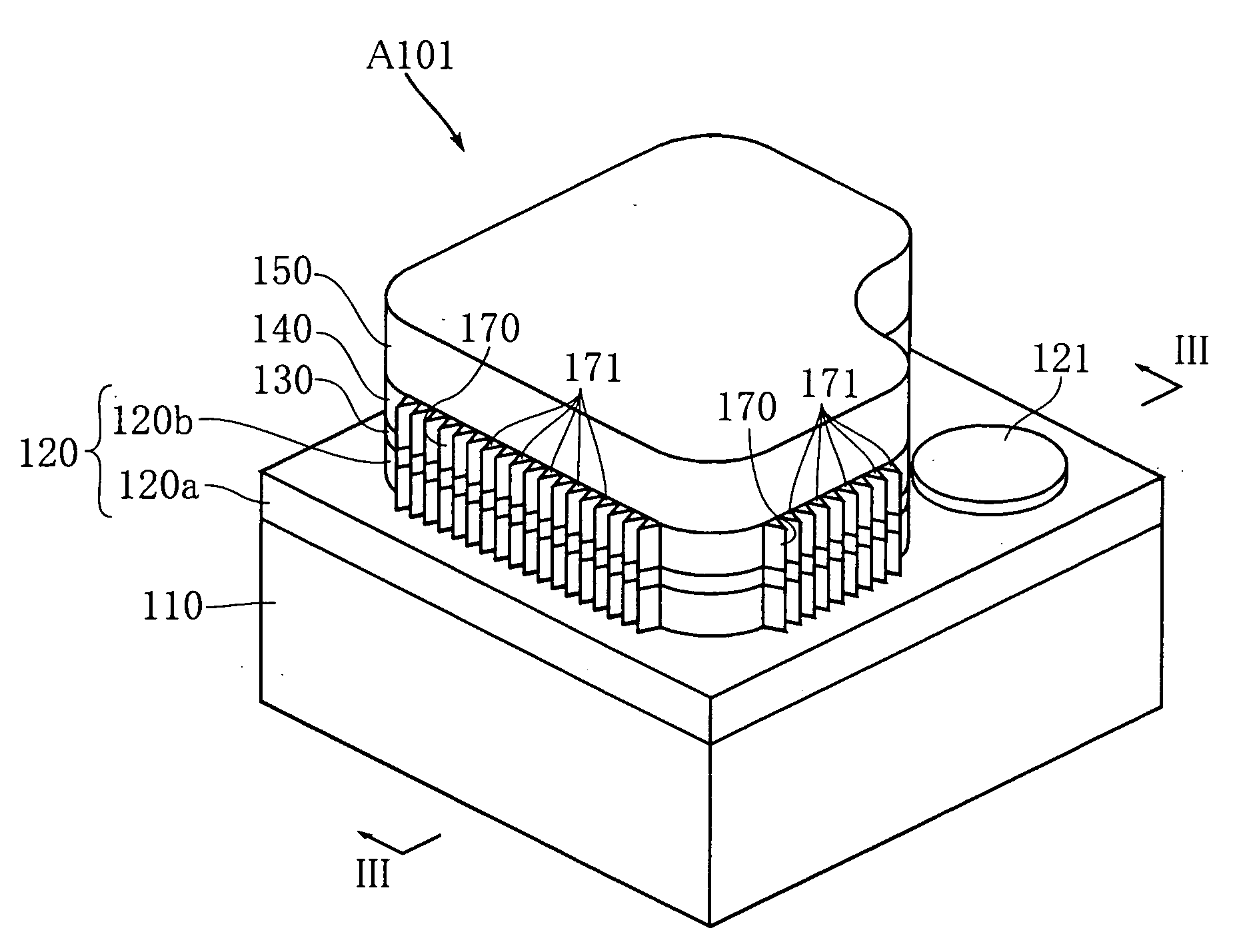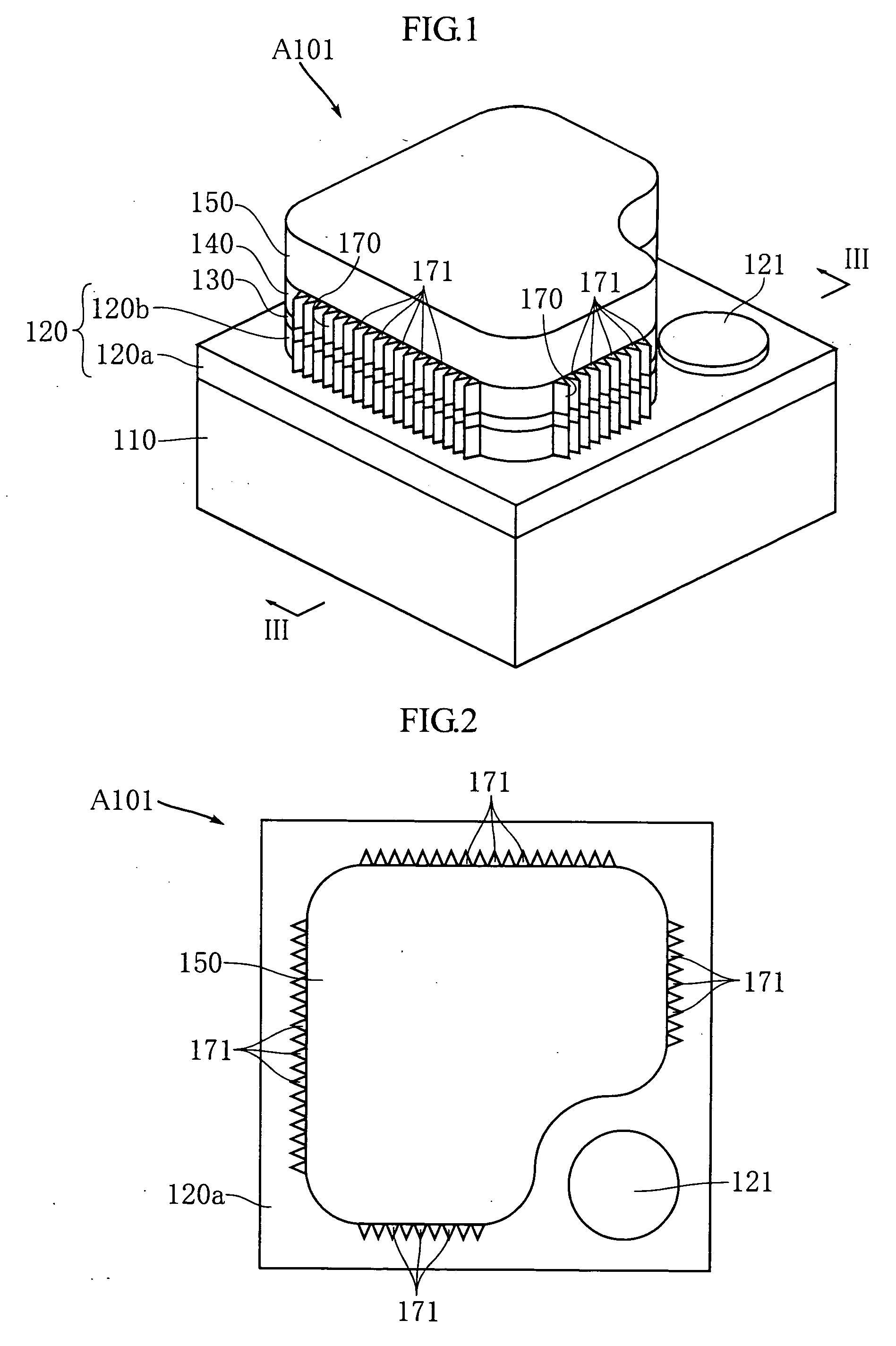Semiconductor Light Emitting Element
a technology of light-emitting elements and semiconductors, which is applied in the direction of basic electric elements, semiconductor devices, electrical equipment, etc., can solve the problems of difficult to cause the recombination of electrons and holes, difficulty in achieving light-emitting power, and inability to achieve high brightness, etc., to achieve the effect of increasing the light-emitting ratio, increasing the light-emitting amount and high brightness
- Summary
- Abstract
- Description
- Claims
- Application Information
AI Technical Summary
Benefits of technology
Problems solved by technology
Method used
Image
Examples
first embodiment
[0066]FIGS. 1-3 show a semiconductor light emitting element according to the present invention. The semiconductor light emitting element A101 of this embodiment includes a substrate 110, an n-GaN layer 120, an active layer 130, a p-GaN layer 140 and a ZnO electrode 150. The semiconductor light emitting element A101 is particularly designed to emit blue light or green light.
[0067]The substrate 110 is made of e.g. sapphire and supports the n-GaN layer 120, the active layer 130, the p-GaN layer 140 and the ZnO electrode 150. In this embodiment, the substrate 110 has a thickness of about 80 μm. A buffer layer (not shown) made of e.g. AlN, GaN or AlGaN to alleviate lattice strain is formed on the substrate 110.
[0068]The n-GaN layer 120 is made of an n-type semiconductor formed by doping Si into GaN and an example of n-type semiconductor layer of the present invention. In this embodiment, the n-GaN layer 120 has a thickness of about 3 to 6 μm. As shown in FIG. 3, the n-GaN layer 120 compr...
second embodiment
[0089]FIG. 7 shows a semiconductor light emitting element according to the present invention. The semiconductor light emitting element A102 of this embodiment differs from that of the foregoing embodiment in that a plurality of projections 171 are formed also on the substrate 110 and the first layer 120a of the n-GaN layer 120. The projections 171 of this embodiment have the same cross sectional configuration as that of the projections 171 shown in FIG. 4. The projections 171 can be formed by subjecting the substrate 110 and the n-GaN layer 120 to etching or dicing using a dicing blade formed with triangular grooves.
[0090]According to this embodiment, owing to the provision of the projections 171, the light traveling from the active layer 130 and reaching the first layer 120a of the n-GaN layer 120 and the substrate 110 through the second layer 120b of the n-GaN layer 120 is efficiently emitted. Thus, the semiconductor light emitting element A102 is capable of emitting a larger amou...
third embodiment
[0091]FIGS. 8 and 9 show a semiconductor light emitting element according. to the present invention. The semiconductor light emitting element A103 of this embodiment differs from those of the foregoing embodiments in that a plurality of cone-shaped projections 172 are provided. Further, the lamination structure of the semiconductor light emitting element A103 differs from that of the foregoing embodiments.
[0092]Specifically, the semiconductor light emitting element A103 includes a substrate 110, and an n-GaN layer 120, an active layer 130 and a p-GaN layer 140 which are laminated on one surface side of the substrate 110. The substrate 110 is made of SiC and includes a prismatic portion on the upper side in the figure and a tapered portion on the lower side in the figure. The surface of the substrate 110, which is opposite from the surface formed with the n-GaN layer 120, is formed with an n-side electrode 121. A reflective layer 160 is formed on the lower surface of the p-GaN layer ...
PUM
 Login to View More
Login to View More Abstract
Description
Claims
Application Information
 Login to View More
Login to View More - R&D
- Intellectual Property
- Life Sciences
- Materials
- Tech Scout
- Unparalleled Data Quality
- Higher Quality Content
- 60% Fewer Hallucinations
Browse by: Latest US Patents, China's latest patents, Technical Efficacy Thesaurus, Application Domain, Technology Topic, Popular Technical Reports.
© 2025 PatSnap. All rights reserved.Legal|Privacy policy|Modern Slavery Act Transparency Statement|Sitemap|About US| Contact US: help@patsnap.com



